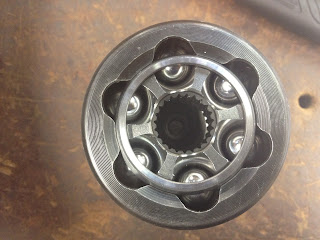Tripod Joint
Also known as inner CV joint, consists of housing and spider assembly. Has 3 needle bearing rollers on the spider that can slide inside the housing with 3 roller channels. This allows the tripod joint to slide back and forth, enabling the driveshaft to extend when the angle changed due to suspension movement, to create a smoother ride on an uneven surface.
Rollers on the spider of a Tripod Joint.
The image of a spider assembly.
CV Joint
CV joint is located between the driveshaft and the wheel. Unlike the tripod joint, CV joint is fixed and cannot be extended. It is used to transmit the power from transmission to wheels at constant speed, and ease off the pressure on driveshaft when the suspension moved. The most common type CV joint is Birfield CV joint, it consists of balls, ball cage, inner race with splines and outer housing with a short axle. Usually a CV joint can last for a very long period of time, apart from it's rubber boot. The boot splits and perishes from time to time and needs new replacement otherwise the CV joint will fail and create a clicking noise when turning.
The components of a CV Joint.
The assembly inside the housing of CV Joint.
Image showing the sign of crack of a rubber boot.
Clutch
Clutch is used to engage or disengage between moving objects. It can be found in between the engine and transmission in most of the manual car. A clutch disc is in the middle of the engine flywheel and pressure plate that bolted to the flywheel. When the cone-shaped diaphragm spring is pressed against the pressure plate, the clutch disc is also being squeezed against the flywheel. The friction on the clutch disc is holding the plate and flywheel together, this cause the engagement of the engine and the transmission and make them spin together at the same speed.
When the driver put his foot down on the clutch pedal, the release bearing is being pushed towards the centre of the diaphragm spring causing the spring to distort and pull away the pressure plate from clutch disc to release the clutch free.
Clutch needs to be installed correctly to prevent 'slipping' or 'sticking' problem. The clutch will start to slip when the surface of the clutch disc is worn out and the friction on the disc is damaged. This will stop it from transmitting power to the wheels. When it does not release and keeps sticking to the flywheel, it will stop the car from going into gears.
The pressure plate assembly of a clutch.
The flywheel at the end of the engine.
Image of a clutch disc or friction disc.








No comments:
Post a Comment